Evaluating Pile-Supported Embankment Considering the Soil Anisotropy Effect
Abstract
Featured Application
Abstract
1. Introduction
2. Description of the Model
2.1. Flow Rule
2.2. Anisotropic Plasticity Theory
2.3. UMAT Subroutine Call
3. Finite Element Analyses
3.1. General Description
3.2. Constitutive Models
3.3. Simulation Procedure
3.4. Calibration Results
4. Soil Arching Considering the Cohesion Anisotropy
4.1. Cohesion Anisotropy
4.2. Cohesion Parameter Analysis
4.3. The Stress Distribution in Embankments Is Influenced by the Anisotropy of Cohesive Force
4.4. The Tensile Stiffness of Geogrid Is Affected by the Anisotropy of Cohesion
4.5. Embankment Settlement Is Affected by the Anisotropy of Cohesion
5. Soil Arching Considering Friction Angle Anisotropy
5.1. Friction Angle Anisotropy
5.2. Friction Angle Parameter Analysis
5.3. The Stress Distribution of Embankment Is Affected by the Anisotropy of Friction Angle
5.4. The Tensile Stiffness of Geogrid Is Affected by the Anisotropy of Friction Angle
5.5. Embankment Settlement Is Affected by Friction Angle Anisotropy
6. Engineering Example Verification and Related Design Description
6.1. Engineering Example Verification
6.2. Anisotropic Soil Construction Design
- (1)
- Filler direction: determine the layout direction of the filler layer to make full use of the high shear strength of the soil in the direction perpendicular to the embankment. The preferred direction of the filler can be selected to be consistent with the longitudinal direction of the vertical embankment to improve the overall stability of the embankment.
- (2)
- Filler type and thickness: Considering the low shear strength of the soil in the transverse direction of the embankment, high-strength filler material can be selected or the thickness of the filler layer can be increased to improve the bearing capacity of the embankment in the transverse direction.
- (3)
- Foundation treatment: According to the research results of soil anisotropy, appropriate foundation treatment measures can be considered, such as reducing pile spacing or increasing multi-layer geogrid, so as to further improve the stability of the embankment in different directions.
7. Conclusions
- (1)
- The Mohr–Coulomb yield criterion incorporates anisotropic considerations for cohesion, treating cohesion as a function of the direction of the principal stress. This approach enables dynamic updates of cohesion with changes in the direction of major principal stress in the code. When examining the effects of anisotropy on pile–soil stress ratios with a cohesive strength of 5 kPa, it was observed that as the anisotropy of cohesion intensifies and the anisotropy coefficient diminishes from 1 to 0.3, the ratio decreases from 36.1 to 28.8. Additionally, there is a notable 12.1% increase in settlement at the top of the embankment, highlighting the impact of cohesion anisotropy on geotechnical structural performance.
- (2)
- This paper presents an advancement of the Mohr–Coulomb criterion by incorporating a variable function that represents the dependence of friction angles on the direction of shear stress. This extension allows for the consideration of friction angle anisotropy in the material subroutine, enhancing the accuracy and adaptability of the yield criterion. Through an investigation of cases with a fixed friction angle of 30°, it was observed that as the coefficient of friction angle anisotropy increased from 1 to 1.48, resulting in heightened anisotropy, the pile–soil stress ratio experienced a significant decrease, dropping from 23.7 to 17.4. Additionally, the friction angle anisotropy exhibited a correspondence with an increased settlement at the pinnacle of the embankment, with the settlement of the top surface of the embankment increasing by 21.2%.
- (3)
- A numerical model consistent with the existing model test and field test is established. By comparing the field test results with the numerical calculation results using the anisotropic Mohr–Coulomb yield criterion, it is found that the calculation results under anisotropic conditions are closer to the actual situation than isotropic, which verifies the accuracy and applicability of the anisotropic numerical calculation method in this paper.
Author Contributions
Funding
Institutional Review Board Statement
Informed Consent Statement
Data Availability Statement
Conflicts of Interest
Nomenclature
| Serial number | Parameter | Definition |
| 1 | plastic flow factor | |
| 2 | G | plastic potential function |
| 3 | plastic strain rate | |
| 4 | σ | stress |
| 5 | b | derivative of the plastic potential function G to the stress |
| 6 | Rmc | yield curve shape of the yield function on the partial plane |
| 7 | p | average stress |
| 8 | ε | meridian eccentricity |
| 9 | c|0 | initial cohesion |
| 10 | ψ | dilatancy angle |
| 11 | Rmw(θ, e) | triple symmetric elliptic form of the plastic potential function on the partial plane |
| 12 | q | deviatoric stress |
| 13 | θ | Lode angle |
| 14 | e | eccentricity on the π plane |
| 15 | φ | friction angle of the soil |
| 16 | I | identity matrix |
| 17 | φi | interface friction angle |
| 18 | E | elastic modulus |
| 19 | v | Poisson ratio |
| 20 | c | cohesion |
| 21 | γ | unit weight |
| 22 | λ | compression index |
| 23 | κ | rebound index |
| 24 | M | critical state stress ratio |
| 25 | γʹ | soft soil unit weight |
| 26 | e1 | intercept of the slope of the e-lnp normal consolidation curve |
| 27 | ci | anisotropic cohesion |
| 28 | ch | horizontal cohesion |
| 29 | cv | vertical cohesion |
| 30 | i | angle between the large principal stress and the vertical direction |
| 31 | σx | horizontal stress |
| 32 | σz | vertical stress |
| 33 | τxz | shear stress |
| 34 | k | anisotropy coefficient |
| 35 | n | unit vector |
| 36 | nv | vertical component of the unit vector n. |
| 37 | φ0 | friction angle in each direction |
| 38 | φv | vertical friction angle in the direction of shear stress |
| 39 | φh | horizontal friction angle in the direction of shear stress. |
| 40 | Ar | anisotropy ratio |
| 41 | r | third deviatoric stress invariant |
| 42 | S | deviatoric stress |
| 43 | a | first derivative of the yield function with respect to stress |
Appendix A
References
- Krabbenhøft, K.; Krabbenhøft, J. Simplified kinematic hardening plasticity framework for constitutive modelling of soils. Comput. Geotech. 2021, 138, 104146. [Google Scholar] [CrossRef]
- Arthur, J.R.F.; Menzies, B.K. Inherent Anisotropy in a Sand. Géotechnique 1973, 22, 115–128. [Google Scholar] [CrossRef]
- Lade, P.; Abelev, A. Characterization of Cross-Anisotropic Soil Deposits from Isotropic Compression Tests. Soils Found. 2005, 45, 89–102. [Google Scholar] [CrossRef] [PubMed]
- Abelev, A.V.; Lade, P.V. Characterization of Failure in Cross-Anisotropic Soils. J. Eng. Mech. 2004, 130, 599–606. [Google Scholar] [CrossRef]
- Azami, A.; Pietruszczak, S.; Guo, P. Bearing Capacity of Shallow Foundations in Transversely Isotropic Granular Media. Int. J. Numer. Anal. Methods Geomech. 2010, 34, 771–793. [Google Scholar] [CrossRef]
- Symes, M.J.; Genst, A.; Hight, D.W. Drained Principal Stress Rotation in Saturated Sand. Géotechnique 1988, 38, 59–81. [Google Scholar] [CrossRef]
- Symes, M.J.P.R.; Gens, A.; Hight, D.W. Undrained Anisotropy and Principal Stress Rotation in Saturated Sand. Géotechnique 1984, 34, 11–27. [Google Scholar] [CrossRef]
- Zamanian, M.; Mollaei-Alamouti, V.; Payan, M. Directional Strength and Stiffness Characteristics of Inherently Anisotropic Sand: The Influence of Deposition Inclination. Soil Dyn. Earthq. Eng. 2020, 137, 106304. [Google Scholar] [CrossRef]
- Daraei, A.; Herki, M.B.; Sherwani, H.F.A.; Shokrollah, Z. Rehabilitation of Portal Subsidence of Heybat Sultan Twin Tunnels: Selection of Shotcrete or Geogrid Alternatives. Int. J. Geosynth. Ground Eng. 2018, 4, 15. [Google Scholar] [CrossRef]
- Daraei, A.; Herki, A.M.B.; Sherwani, H.F.A.; Zare, S. Slope Stability in Swelling Soils Using Cement Grout: A Case Study. Int. J. Geosynth. Ground Eng. 2018, 4, 10. [Google Scholar] [CrossRef]
- Arthur, J.R.F.; Chua, K.S.; Dunstan, T. Induced Anisotropy in a Sand. Géotechnique 1977, 27, 13–30. [Google Scholar] [CrossRef]
- Mahmoudi, M.; Rajabi, A.M. A numerical simulation using FLAC3D to analyze the impact of concealed karstic caves on the behavior of adjacent tunnels. Nat. Hazards 2023, 117, 555–577. [Google Scholar] [CrossRef]
- Meiqin, L.; Shang, W.; Fei, P. Simulation and Analysis of Three-point Bending Experiment with Hollow Beam Based on Abaqus. J. Phys. Conf. Ser. 2023, 2566, 012063. [Google Scholar] [CrossRef]
- Wang, L.F.; He, X.Q.; Sun, Y.Z.; Liew, K.M. A mesh-free vibration analysis of strain gradient nano-beams. Eng. Anal. Bound. Elem. 2017, 84, 231–236. [Google Scholar] [CrossRef]
- Ma, X.; Kiani, K. Spatially nonlocal instability modeling of torsionaly loaded nanobeams. Eng. Anal. Bound. Elem. 2023, 154, 29–46. [Google Scholar] [CrossRef]
- Kiani, K. Nanomechanical sensors based on elastically supported double-walled carbon nanotubes. Appl. Math. Comput. 2015, 270, 216–241. [Google Scholar] [CrossRef]
- Peng, L.X.; Liew, K.M.; Kitipornchai, S. Buckling and free vibration analyses of stiffened plates using the FSDT mesh-free method. J. Sound Vib. 2006, 289, 421–449. [Google Scholar] [CrossRef]
- Kiani, K. Column buckling of magnetically affected stocky nanowires carrying electric current. J. Phys. Chem. Solids 2015, 83, 140–151. [Google Scholar] [CrossRef]
- Zhang, L.W.; Zhang, Y.; Liew, K.M. Modeling of nonlinear vibration of graphene sheets using a meshfree method based on nonlocal elasticity theory. Appl. Math. Model. 2017, 49, 691–704. [Google Scholar] [CrossRef]
- Kiani, K. Nonlocal discrete and continuous modeling of free vibration of stocky ensembles of vertically aligned single-walled carbon nanotubes. Curr. Appl. Phys. 2014, 14, 1116–1139. [Google Scholar] [CrossRef]
- Bu, N.; Zhang, Y.; Li, X.; Chen, W.; Jiang, C. Contact High-Temperature Strain Automatic Calibration and Precision Compensation Research. J. Artif. Intell. Technol. 2022, 2, 69–76. [Google Scholar] [CrossRef]
- Du, H.; Du, S.; Li, W. Probabilistic time series forecasting with deep non-linear state space models. CAAI Trans. Intell. Technol. 2023, 8, 3–13. [Google Scholar] [CrossRef]
- Benali, A.; Hachama, M.; Bounif, A.; Nechnech, A.; Karray, M. A TLBO-optimized artificial neural network for modeling axial capacity of pile foundations. Eng. Comput. 2021, 37, 675–684. [Google Scholar] [CrossRef]
- Chen, J.; Yu, S.; Wei, W.; Ma, Y. Matrix-based method for solving decision domains of neighbourhood multigranulation decision-theoretic rough sets. CAAI Trans. Intell. Technol. 2022, 7, 313–327. [Google Scholar] [CrossRef]
- Yao, Z.W.; Huang, Q.; Ji, Z.; XF, L.; Bi, Q. Deep learning-based prediction of piled-up status and payload distribution of bulk material. Autom. Constr. 2021, 121, 103424. [Google Scholar] [CrossRef]
- Che, J.; Tong, X.; Yu, L. A dynamic bidirectional heuristic trust path search algorithm. CAAI Trans. Intell. Technol. 2022, 7, 340–353. [Google Scholar] [CrossRef]
- Wang, H.; Yue, W.; Wen, S.; Xu, X.; Haasis, H.D.; Su, M.; Liu, P.; Zhang, S.; Du, P. An improved bearing fault detection strategy based on artificial bee colony algorithm. CAAI Trans. Intell. Technol. 2022, 7, 570–581. [Google Scholar] [CrossRef]
- Jackson-Mills, G.; Barber, A.R.; Blight, A.; Pickering, A.; Boyle, J.H.; Richardson, R.C. Non-assembly 3D-printed walking mechanism utilising a hexapod gait. J. Artif. Intell. Technol. 2022, 2, 158–163. [Google Scholar] [CrossRef]
- Hsiao, I.H.; Chung, C.Y. AI-infused semantic model to enrich and expand programming question generation. J. Artif. Intell. Technol. 2022, 2, 47–54. [Google Scholar] [CrossRef]
- Li, Y.Q.; Goh, A.T.C.; Zhang, R.H.; Zhang, W.G. Stability charts for undrained clay slopes considering soil anisotropic characteristics. Bull. Eng. Geol. Environ. 2023, 82, 52. [Google Scholar] [CrossRef]
- Tian, Y.; Yao, Y.P. Constitutive modeling of principal stress rotation by considering inherent and induced anisotropy of soils. Acta Geotech. 2018, 13, 1299–1311. [Google Scholar] [CrossRef]
- Tian, Y.; Yao, Y. A simple method to describe three-dimensional anisotropic failure of soils. Comput. Geotech. 2017, 92, 210–219. [Google Scholar] [CrossRef]
- Yao, Y.; Tian, Y.; Gao, Z. Anisotropic UH model for soils based on a simple transformed stress method. Int. J. Numer. Anal. Methods Geomech. 2017, 41, 54–78. [Google Scholar] [CrossRef]
- Chen, L. Studay on the Anisotropy of Clay. Appl. Mech. Mater. 2012, 1931, 193–194. [Google Scholar] [CrossRef]
- Lade, P.V.; Rodriguez, N.M.; Van, D.E.J. Effects of Principal Stress Directions on 3D Failure Conditions in Cross Anisotropic Sand. J. Geotech. Geoenvironmental Eng. 2014, 140, 1–12. [Google Scholar] [CrossRef]
- Kirkgard, M.M.; Lade, P.V. Anisotropic Three-Dimensional Behavior of a Normally Consolidated Clay. Can. Geotechnical. J. 1993, 30, 848–858. [Google Scholar] [CrossRef]
- Lam, W.; Tatsuoka, F. Effects of Initial Anisotropic Fabric and σ2 on Strength and Deformation Characteristics of Sand. Soils Found. 1988, 28, 89–106. [Google Scholar] [CrossRef]
- Zdravkovic, L.; Potts, D.M.; Hight, D.W. The Effect of Strength Anisotropy on the Behaviour of Embankments on Soft Ground. Géotechnique 2002, 52, 447–457. [Google Scholar] [CrossRef]
- Bhasi, A.; Rajagopal, K. Numerical study of basal reinforced embankments supported on floating/end bearing piles considering pile–soil interaction. Geotext. Geomembr. 2015, 43, 524–536. [Google Scholar] [CrossRef]
- Van, S.J.M.; Bezuijen, A.; Lodder, H.J.; Van Tol, A.F. Model experiments on piled embankments. Part, I. Geotext. Geomembr. 2012, 32, 69–81. [Google Scholar] [CrossRef]
- Lai, H.; Zheng, J.; Zhang, J.; Zhang, R.; Cui, L. DEM analysis of “soil”-arching within geogrid-reinforced and unreinforced pile-supported embankments. Comput. Geotech. 2014, 61, 13–23. [Google Scholar] [CrossRef]
- Lade, P.V. Failure Criterion for Cross-Anisotropic Soils. J. Geotech. Geoenvironmental Eng. 2008, 134, 117–124. [Google Scholar] [CrossRef]
- Li, X.; Dafalias, Y.F. Constitutive Modeling of Inherently Anisotropic Sand Behavior. J. Geotech. Geoenvironmental Eng. 2002, 128, 868–880. [Google Scholar] [CrossRef]
- Li, X.; Dafalias, Y.F. Constitutive Framework for Anisotropic Sand Including Non-Proportional Loading. Géotechnique 2004, 54, 41–55. [Google Scholar] [CrossRef]
- Dafalias, Y.F.; Papadimitriou, A.G.; Li, X.S. Sand Plasticity Model Accounting for Inherent Fabric Anisotropy. J. Eng. Mech. 2004, 130, 1319–1333. [Google Scholar] [CrossRef]
- Jia, S.P.; Chen, W.Z.; Yang, J.P.; Chen, P.S. An elastoplastic constitutive model based on modified Mohr-Coulomb criterion and its numerical implementation. Rock Soil Mechanics. 2010, 31, 2051–2058. [Google Scholar] [CrossRef]
- Menetrey, P.H.; Willam, K.J. Triaxial Failure Criterion for Concrete and its Generalization. ACJ Struct. J. 1995, 92, 311–318. [Google Scholar] [CrossRef]
- Zhuang, Y.; Ellis, E.A. Finite-Element Analysis of a Piled Embankment with Reinforcement and Subsoil. Géotechnique 2016, 66, 596–601. [Google Scholar] [CrossRef]
- Liu, H.L.; Ng, C.W.W.; Fei, K. Performance of a geogrid-reinforced and pile-supported highway embankment over soft clay: Case study. J. Geotech. Geoenvironmental Eng. 2007, 133, 1483–1493. [Google Scholar] [CrossRef]
- Potyondy, J.G. Skin friction between various soils and construction materials. Geotechnique 1961, 11, 339–353. [Google Scholar] [CrossRef]
- Chen, W.F.; Snitbhan, N.; Fang, H.Y. Stability of Slopes in Anisotropic, Nonhomogeneous Soils. Can. Geotech. J. 1975, 12, 146–152. [Google Scholar] [CrossRef]
- Penava, D.; Ani, F.; Trajber, D.; Vig, M.; Sigmund, V. Three-dimensional micromodel of clay block masonry wall. Int. J. Mason. Res. Innov. 2016, 1, 282–305. [Google Scholar] [CrossRef]
- Wang, D.; Jin, X. Slope stability analysis by finite elements considering strength anisotropy. Rock Soil Mech. 2008, 29, 667–672. [Google Scholar] [CrossRef]
- Oliveira, V.J.P.; Lemos, J.L. Numerical predictions of the behaviour of soft clay with two anisotropic elastoplastic models. Comput. Geotech. 2011, 38, 598–611. [Google Scholar] [CrossRef][Green Version]
- Jones, B.M.; Plaut, R.H.; Filz, G.M. Analysis of geosynthetic reinforcement in pile-supported embankments. Part I: 3D plate model. Geosynth. Int. 2010, 17, 59–67. [Google Scholar] [CrossRef]
- Halvordson, K.A.; Plaut, R.H.; Filz, G.M. 2010. Analysis of geosynthetic reinforcement in pile-supported embankments. Part II: 3D cable-net model. Geosynth. Int. 2010, 17, 68–76. [Google Scholar] [CrossRef]
- Xv, P.; Shao, S.J.; Zhang, S. Strength criterion of cross-anisotropic Q3 loess. Chin. J. Geotech. Eng. 2018, 40, 116–121. [Google Scholar] [CrossRef]
- Schweiger, H.F.; Wiltafsky, C.; Scharinger, F. A Multilaminate Framework for Modelling Induced and Inherent Anisotropy of Soils. Géotechnique 2009, 59, 87–101. [Google Scholar] [CrossRef]
- Galavi, V.; Schweiger, H.F. A Multilaminate Model with Destructuration Considering Anisotropic Strength and Anisotropic Bonding. Soils Found. 2009, 49, 341–353. [Google Scholar] [CrossRef]
- Pietruszczak, S.; Mroz, Z. Formulation of Anisotropic Failure Criteria Incorporating a Microstructure Tensor. Comput. Geotech. 2000, 26, 105–112. [Google Scholar] [CrossRef]
- Fei, K.; Liu, H.L. Field test study and numerical analysis of a geogridreinforced and pile-supported embankment. Rock Soil Mech. 2009, 30, 1004–1012. [Google Scholar] [CrossRef]
- Sun, R.; Yang, J.S. Axisymmetric adaptive lower bound limit analysis for Mohr-Coulomb materials using Semidefinite programming. Comput. Geotech. 2021, 130, 103906. [Google Scholar] [CrossRef]


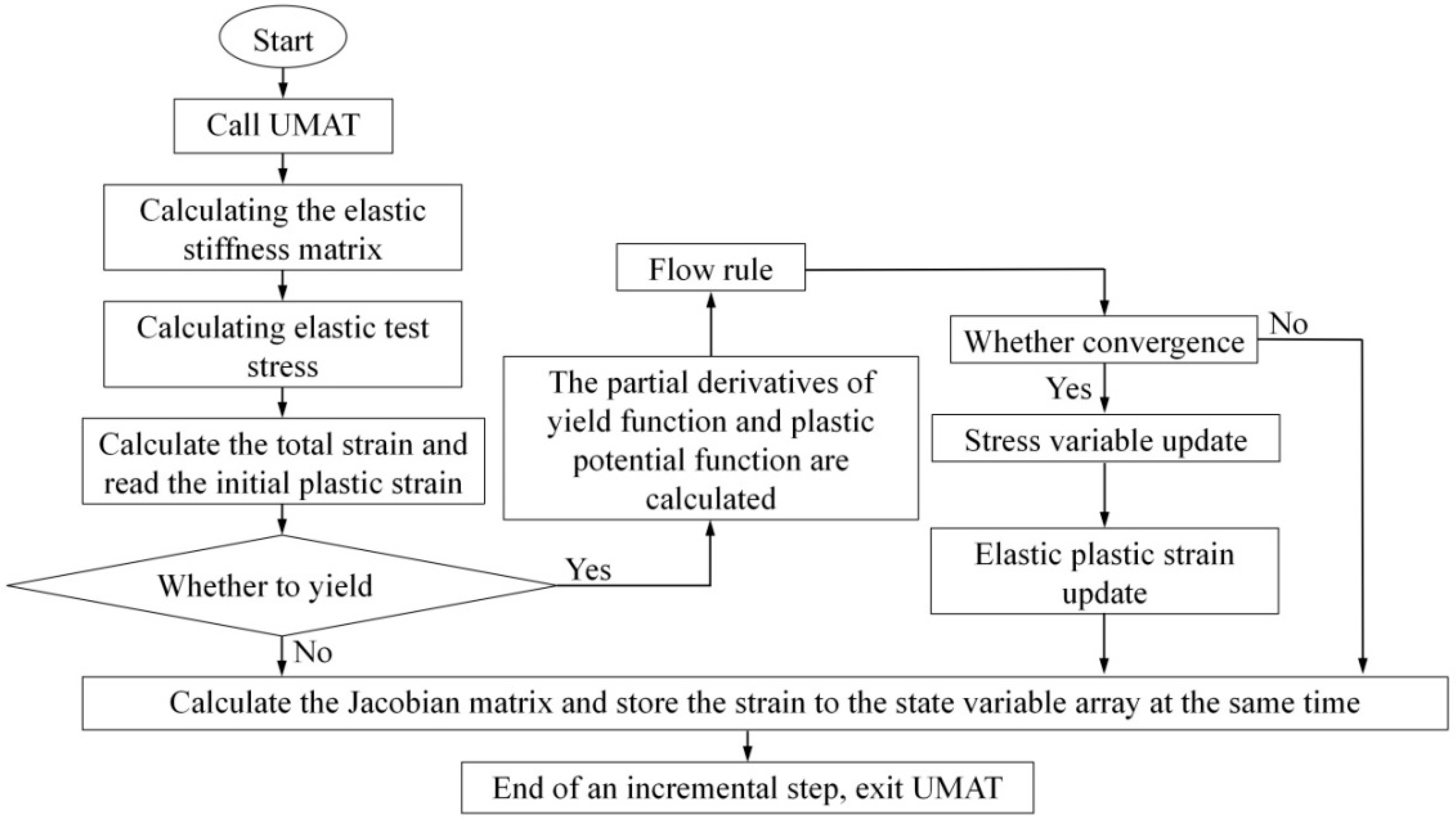
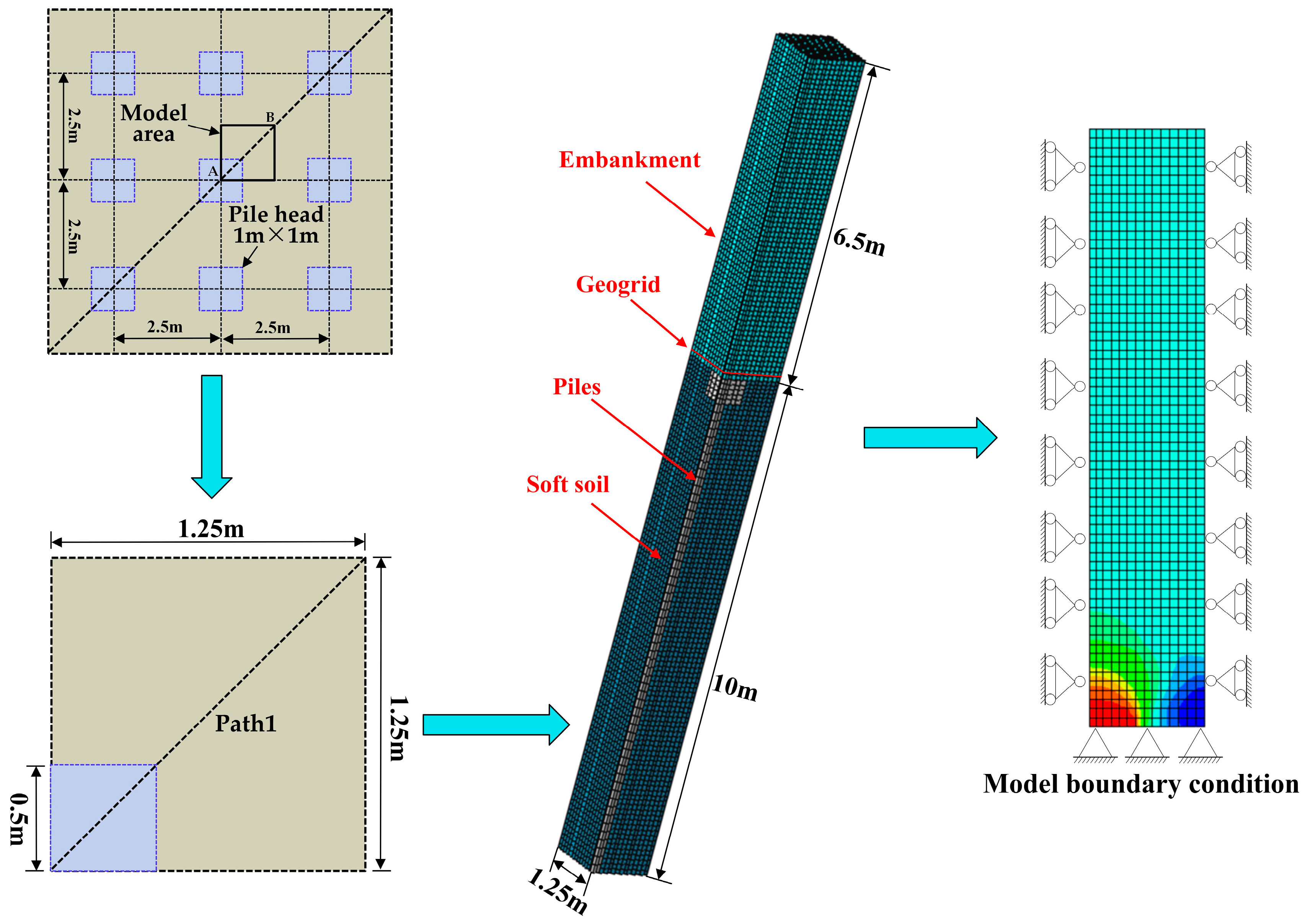
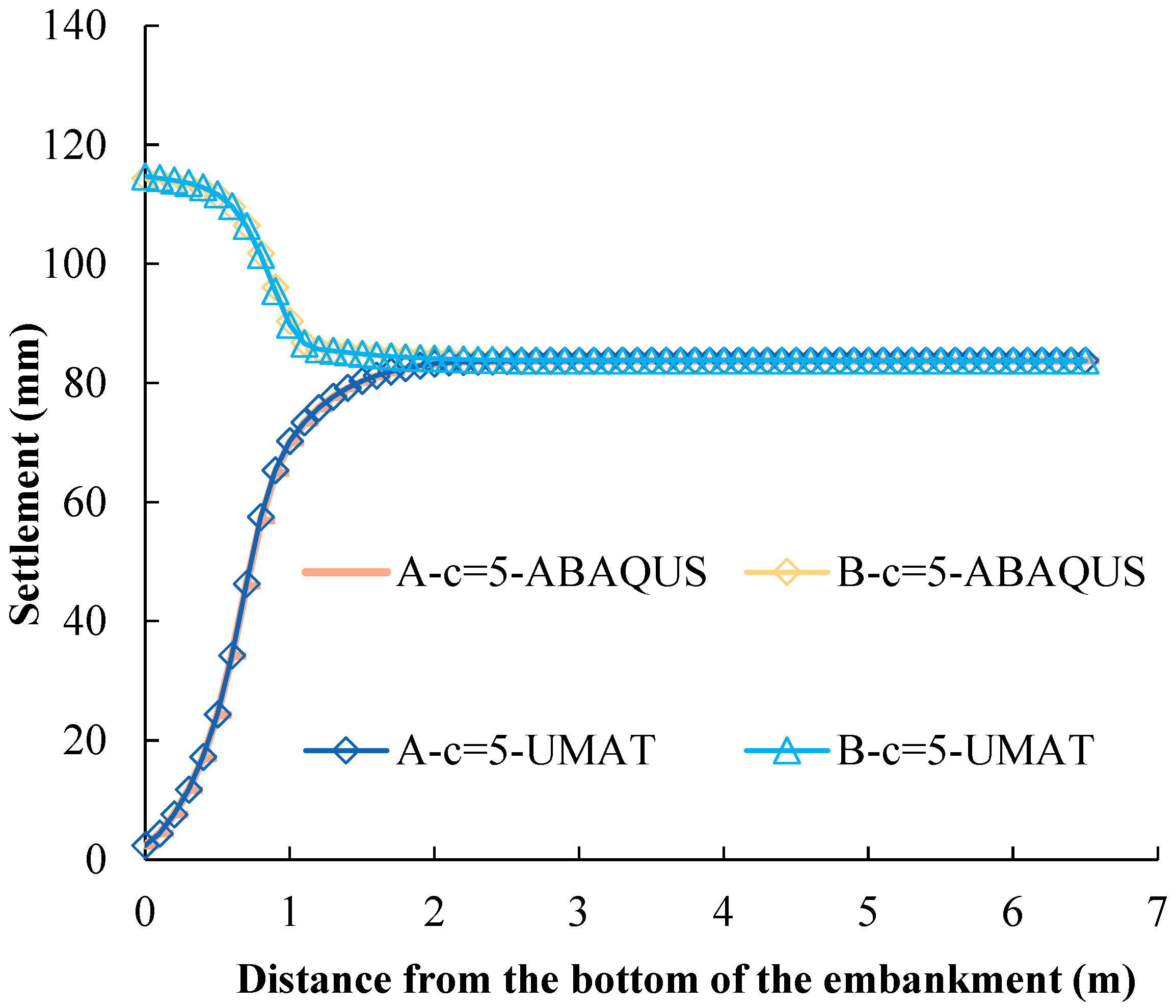
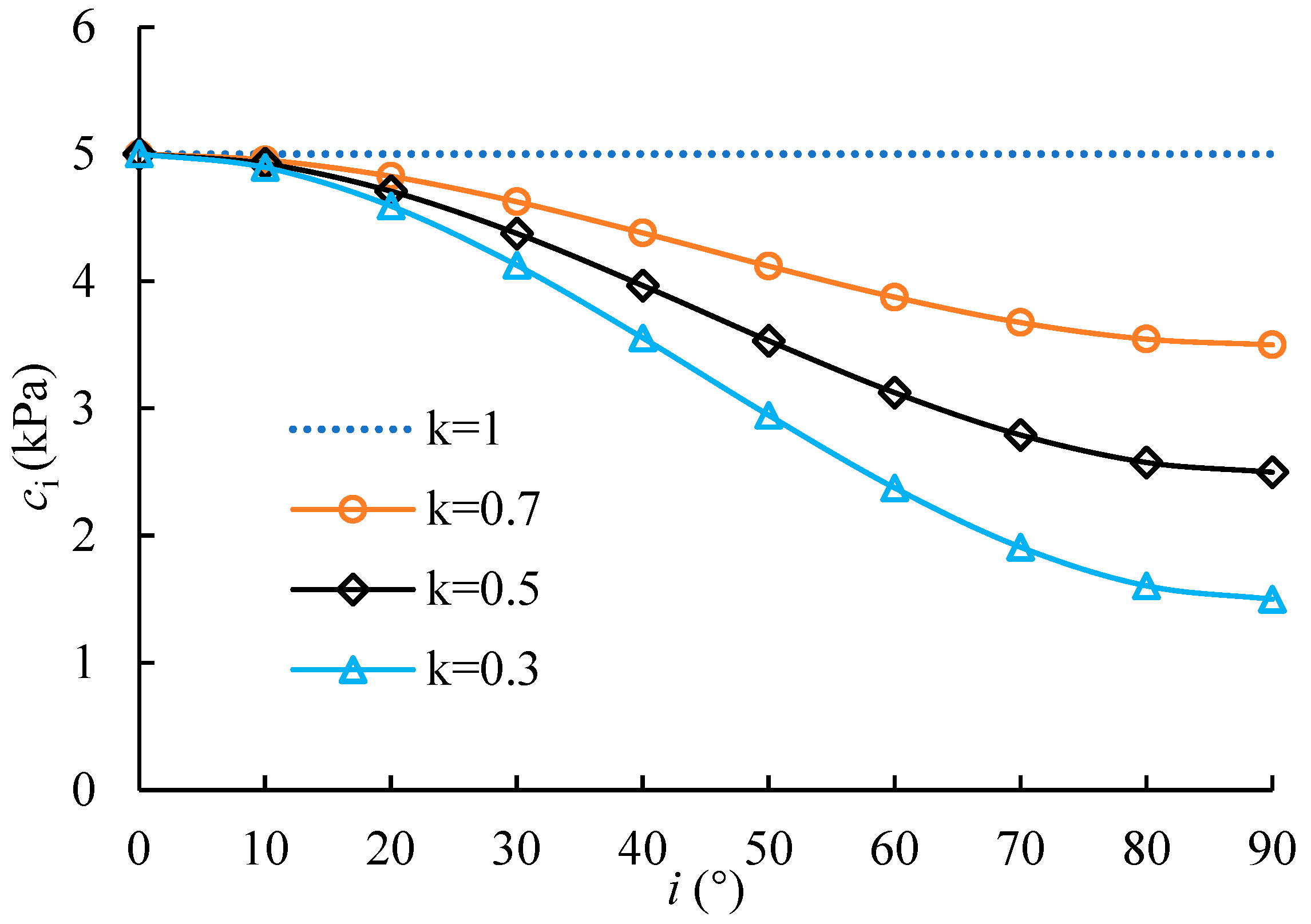


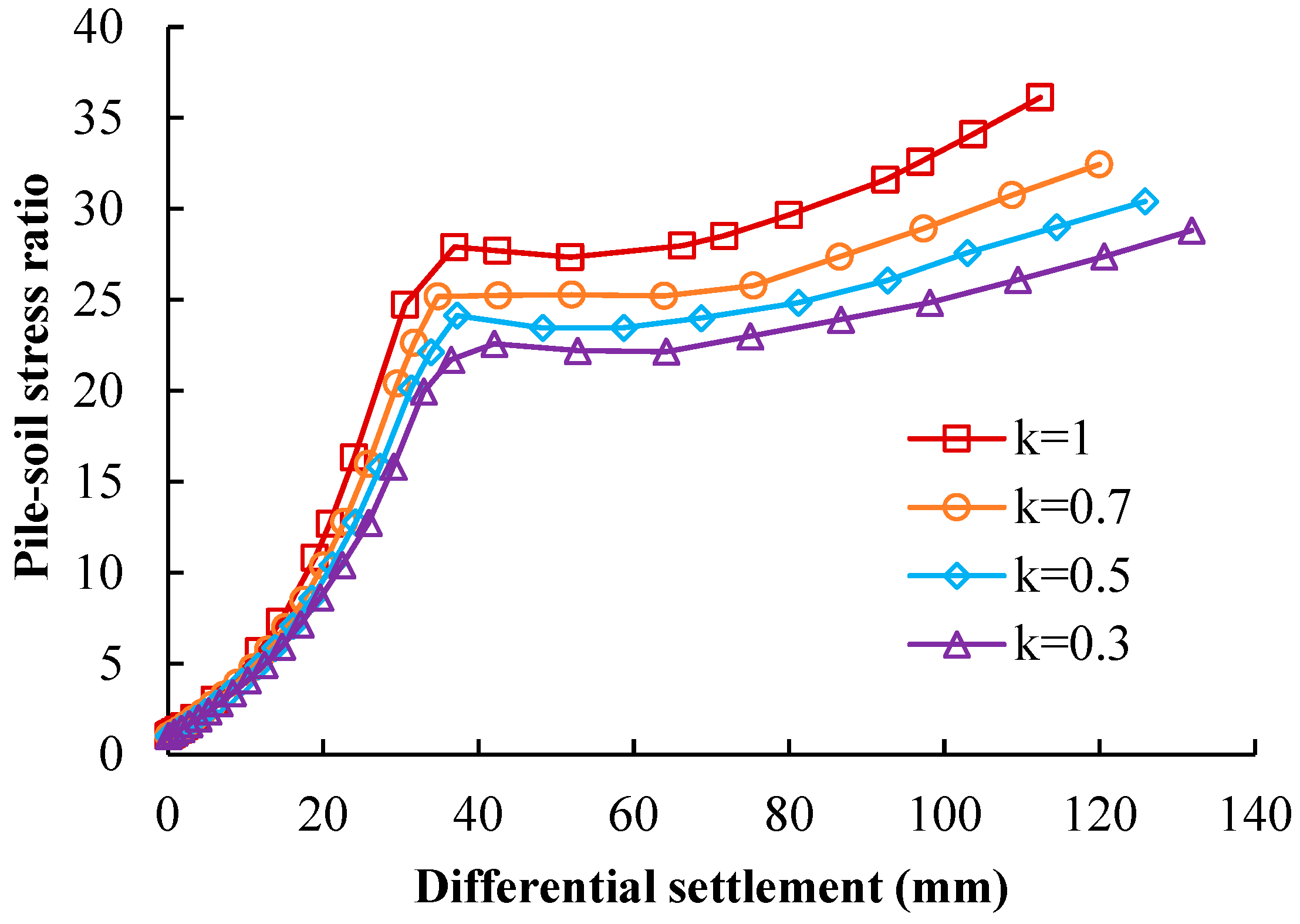

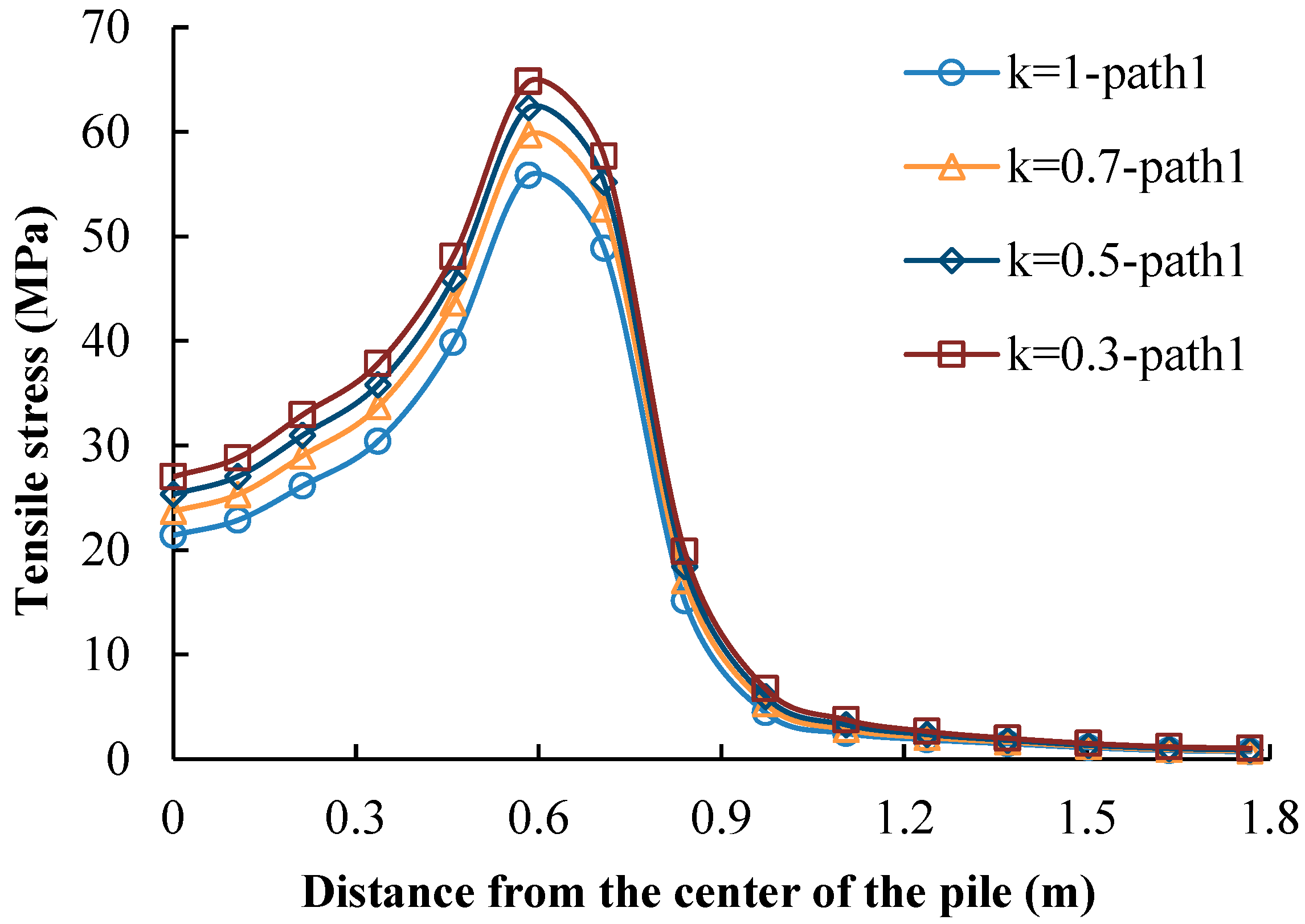
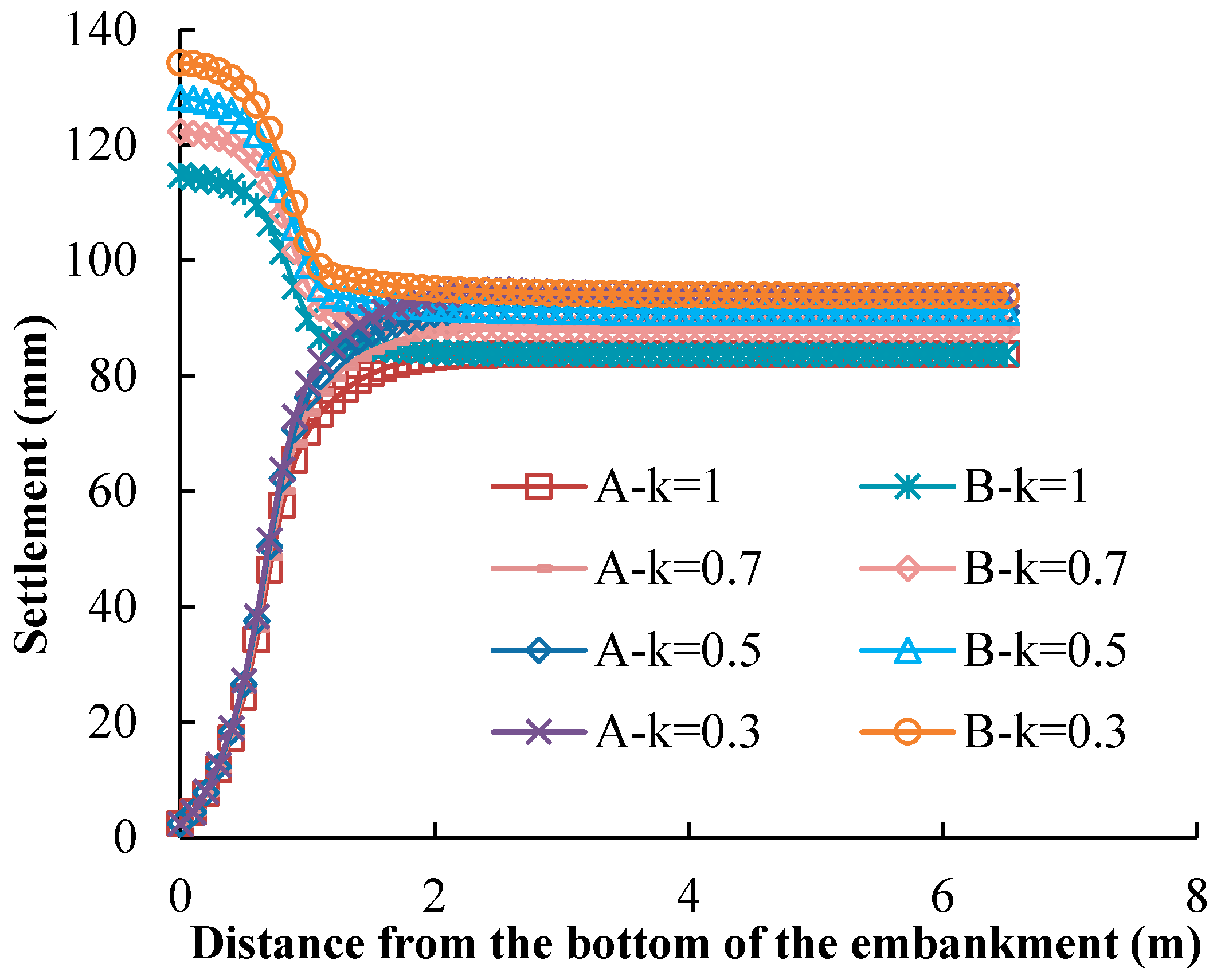


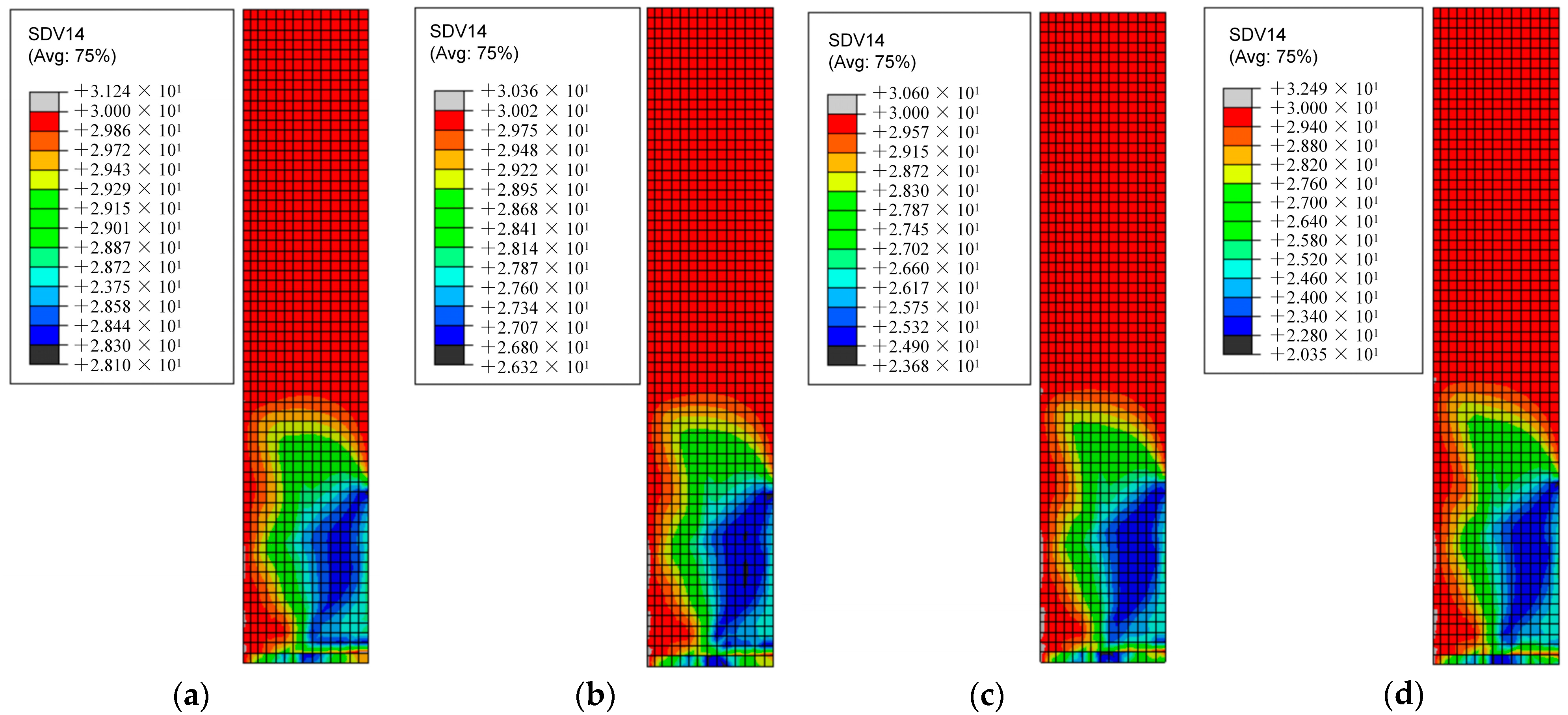
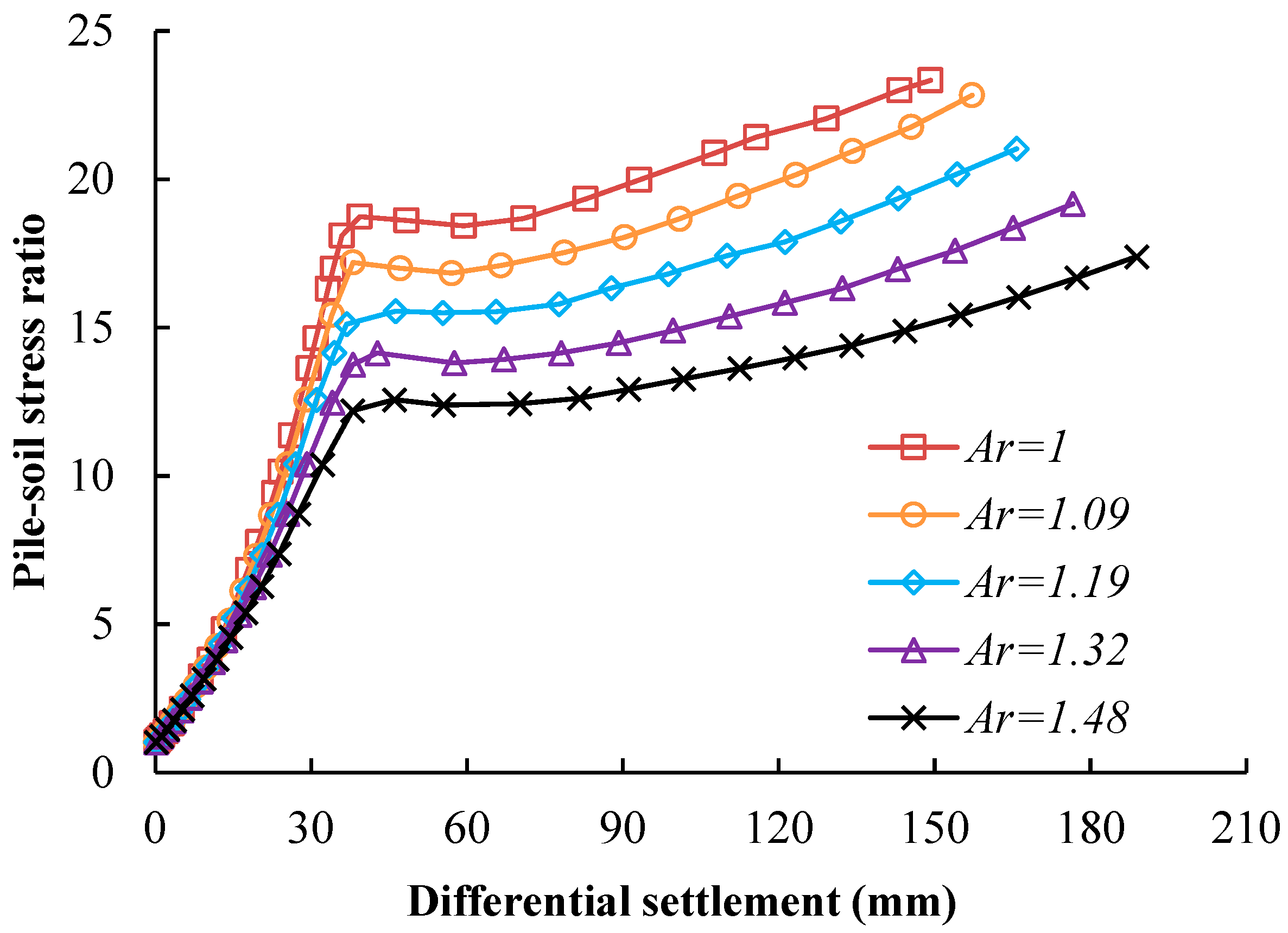
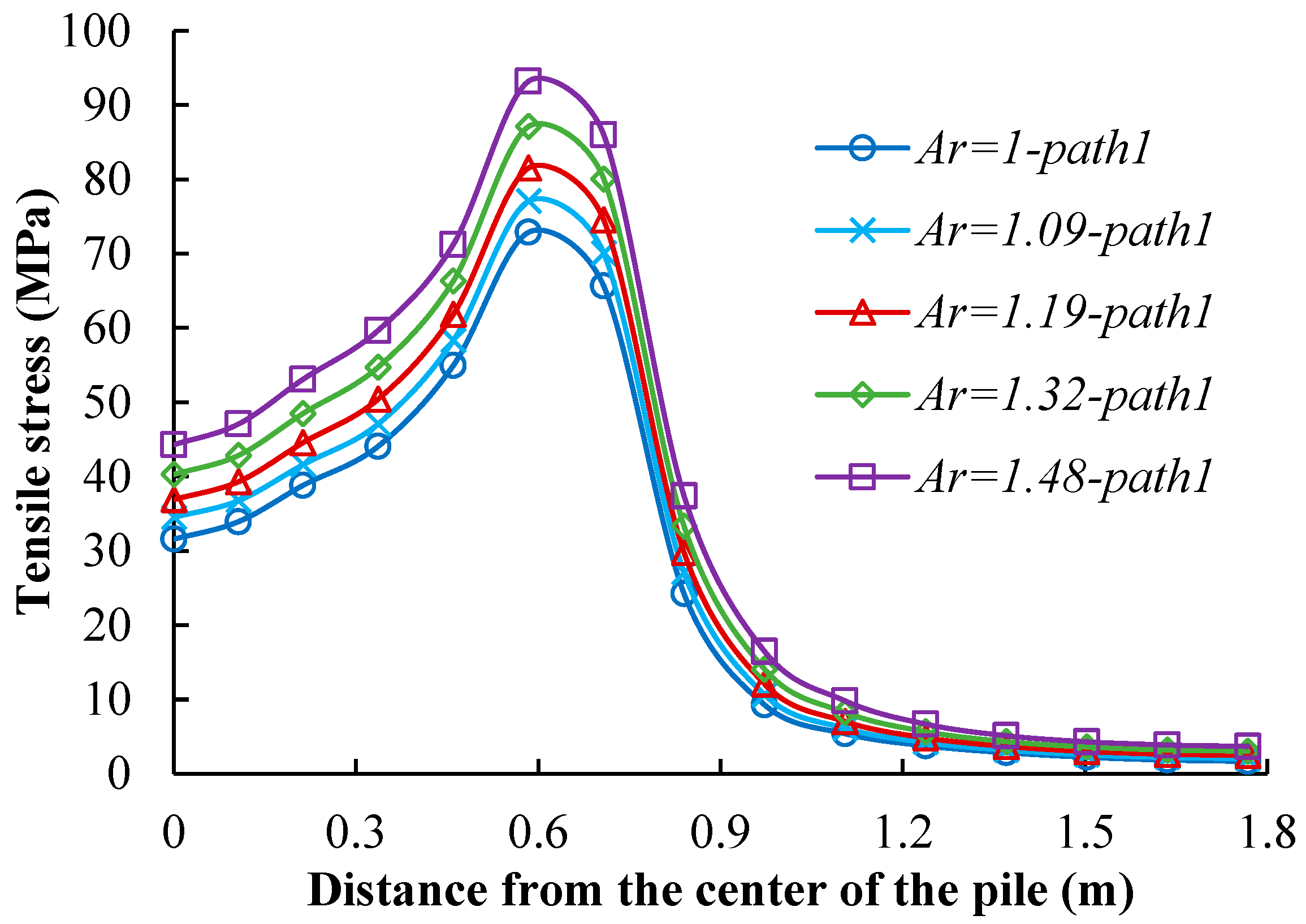
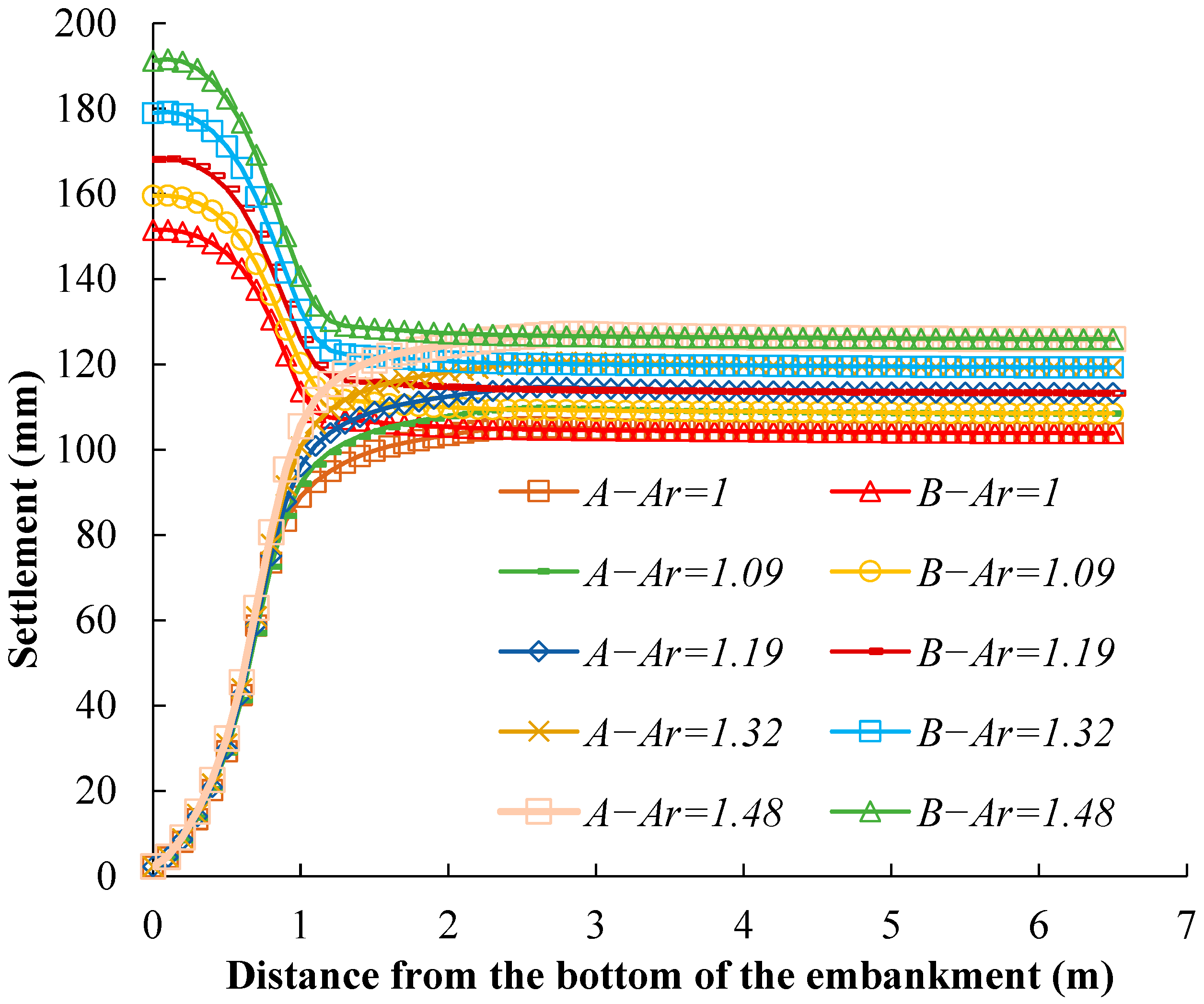
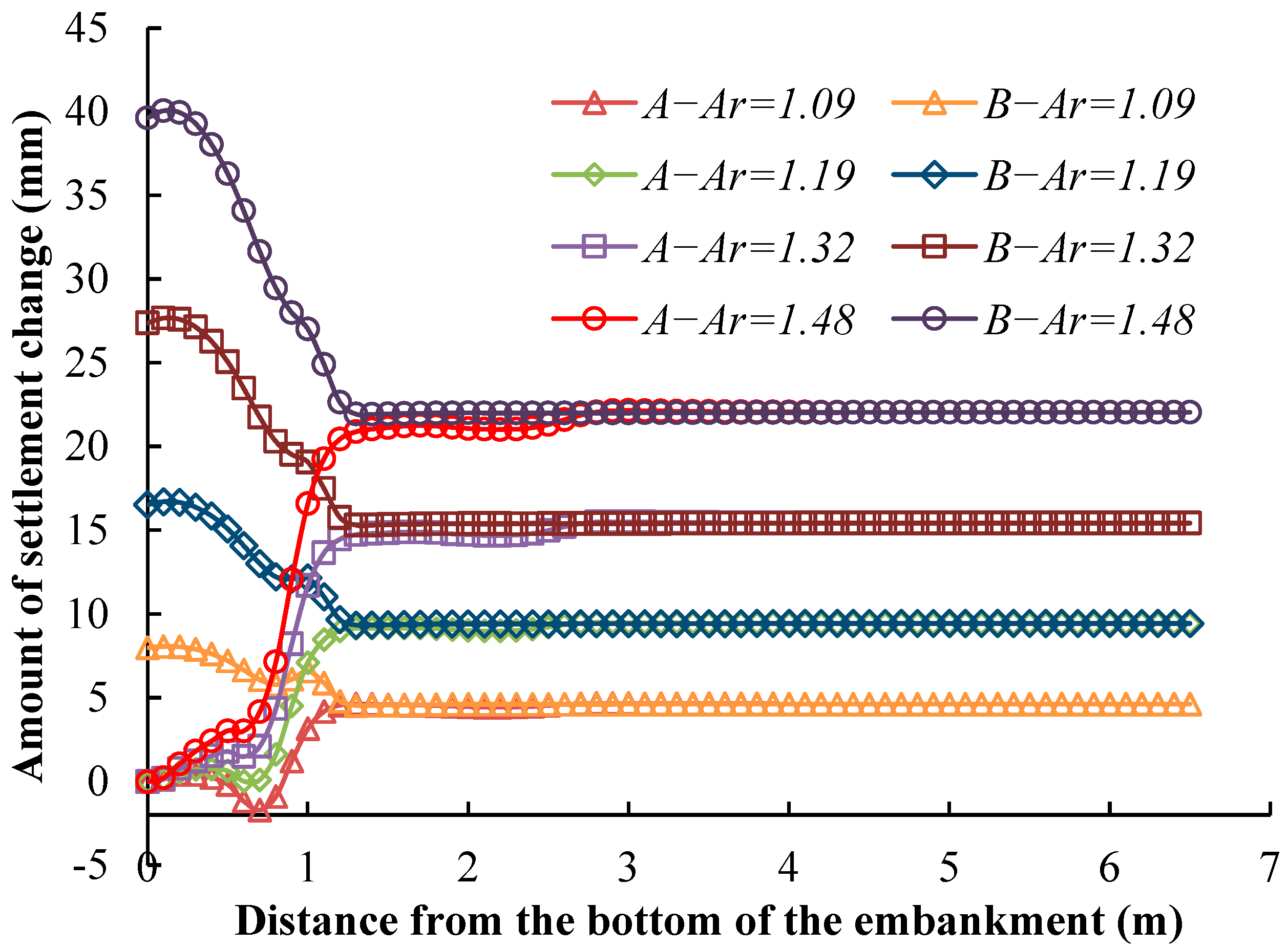
| Material | Model | E (MPa) | v | c (kPa) | φ (°) | Ψ (°) | γ (kN/m3) |
|---|---|---|---|---|---|---|---|
| Pile | Elastic model | 30,000 | 0.2 | / | / | / | 24 |
| Embankment | Mohr–Coulomb | 25 | 0.2 | 5 | 30 | 0 | 17.35 |
| Geogrid | Tensile stiffness 3 MN/m, v = 0 | ||||||
| Material | Model | λ | κ | v | M | e1 | γ′ (kN/m3) |
|---|---|---|---|---|---|---|---|
| Soft soil | The Cam-clay Model | 0.3 | 0.1 | 0.2 | 0.772 | 1.79 | 7.2 |
| Anisotropic Coefficient of Cohesion k | φ (°) | c (kPa) | |
|---|---|---|---|
| cv | ch | ||
| 1 | 30 | 5 | 5 |
| 0.7 | 30 | 5 | 3.5 |
| 0.5 | 30 | 5 | 2.5 |
| 0.3 | 30 | 5 | 1.5 |
| Anisotropic Coefficient of Friction Angle (Ar) | Force of Cohesion (kPa) | Friction Angle (°) | |
|---|---|---|---|
| φv | φh | ||
| 1 | 0.1 | 30 | 30 |
| 1.09 | 0.1 | 30.5 | 28.4 |
| 1.19 | 0.1 | 31 | 26.8 |
| 1.32 | 0.1 | 31.5 | 24.9 |
| 1.48 | 0.1 | 32 | 22.9 |
Disclaimer/Publisher’s Note: The statements, opinions and data contained in all publications are solely those of the individual author(s) and contributor(s) and not of MDPI and/or the editor(s). MDPI and/or the editor(s) disclaim responsibility for any injury to people or property resulting from any ideas, methods, instructions or products referred to in the content. |
© 2023 by the authors. Licensee MDPI, Basel, Switzerland. This article is an open access article distributed under the terms and conditions of the Creative Commons Attribution (CC BY) license (https://creativecommons.org/licenses/by/4.0/).
Share and Cite
Zhuang, Y.; Chen, J.; Wang, Y.; Fan, H.; Chen, Z.; Li, J. Evaluating Pile-Supported Embankment Considering the Soil Anisotropy Effect. Appl. Sci. 2023, 13, 12064. https://doi.org/10.3390/app132112064
Zhuang Y, Chen J, Wang Y, Fan H, Chen Z, Li J. Evaluating Pile-Supported Embankment Considering the Soil Anisotropy Effect. Applied Sciences. 2023; 13(21):12064. https://doi.org/10.3390/app132112064
Chicago/Turabian StyleZhuang, Yan, Jie Chen, Yunlong Wang, Hu Fan, Zhi Chen, and Jinxin Li. 2023. "Evaluating Pile-Supported Embankment Considering the Soil Anisotropy Effect" Applied Sciences 13, no. 21: 12064. https://doi.org/10.3390/app132112064
APA StyleZhuang, Y., Chen, J., Wang, Y., Fan, H., Chen, Z., & Li, J. (2023). Evaluating Pile-Supported Embankment Considering the Soil Anisotropy Effect. Applied Sciences, 13(21), 12064. https://doi.org/10.3390/app132112064





